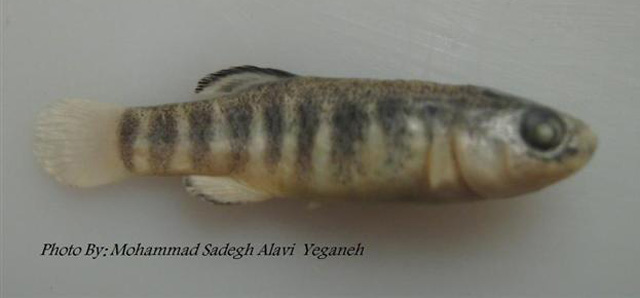| Aphaniidae (Oriental killifishes) |
| 4.284 cm TL (male/unsexed); 3.84 cm SL (female) |
|
benthopelagic; freshwater; depth range 0 - 1 m |
| Asia: Iran. |
|
Dorsal soft rays (total): 10-13; Anal soft rays: 10-12. This species is clearly distinguished at the genetic level from its congeners in having 82 molecular apomorphies-19 transversions, 2 transversions/transitions (depending on comparison), and 61 transitions - that show fixed character state differences to homologous characters analyzed in sophiae, persicus and vladykovi from Iran. Thirty-seven of these character states are also apomorphies when compared to anatoliae, danfordii, villwocki, asquamatus and fasciatus from Turkey (see www.cyprinodontiformes.org).
Males can be distinguished from all other Iranian species by having distinct black edge on the dorsal, anal, and pelvic fins; the dorsal fin is covered with a high density of black blotches (also observed in males of Aphanius anatoliae from Turkey).
Females can be distinguished from those of sophiae and vladykovi by having flank-bars rather than spots; from persicus by less well-defined bars terminating at a mid-flank stripe and a relatively light gray stripe at the caudal-fin base rather than a black spot or blotch. However, flank-bars are also characteristic of females of dispar and fasciatus. Aphanius isfahanensis can be distinguished unambiguously only from vladykovi by a lower lateral-line scale count, but not with any morphometric or meristic character from sophiae or persicus (Ref. 57741). |
| Collected from the lower reaches of the Zayanadeh River, 50 m width and 0.5 m depth, where water temperature is 27°C, pH 6.7, brackish water, conductivity 10.9 mS, dissolved solids 5450 ppm, dissolved oxygen 12.3 mg/L; current is slow and no cover (Ref. 57741). |
|
Not Evaluated (N.E.) Ref. (130435)
|
| harmless |
Source and more info: www.fishbase.org. For personal, classroom, and other internal use only. Not for publication.

